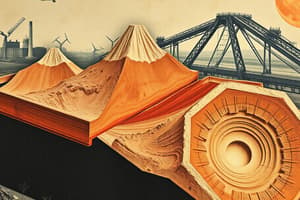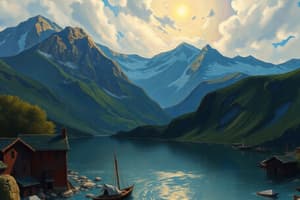Podcast
Questions and Answers
Which term refers to the process by which Earth's continents slowly move over time?
Which term refers to the process by which Earth's continents slowly move over time?
- Continental Drift (correct)
- Density
- Ridge
- Seismic waves
What do we call the outermost shell of Earth, including the crust and upper mantle?
What do we call the outermost shell of Earth, including the crust and upper mantle?
- Pangaea
- Seismic waves
- Lithosphere (correct)
- Ring of Fire
Where do we find a major area in the basin of the Pacific Ocean where many earthquakes and volcanic eruptions occur?
Where do we find a major area in the basin of the Pacific Ocean where many earthquakes and volcanic eruptions occur?
- Density
- Pangaea
- Ring of Fire (correct)
- Ridge
What is the term for the continuous mountain range underwater that winds around the globe?
What is the term for the continuous mountain range underwater that winds around the globe?
What is the name of a person who studies the solid and liquid matter of the earth?
What is the name of a person who studies the solid and liquid matter of the earth?
What moves and causes volcanic eruptions, tsunamis, and earthquakes?
What moves and causes volcanic eruptions, tsunamis, and earthquakes?
What are two lithospheric plates that slide toward each other?
What are two lithospheric plates that slide toward each other?
What are seismic waves recorded on?
What are seismic waves recorded on?
What is a tsunami?
What is a tsunami?
Describe Alfred Wegener & his theory of Pangaea.
Describe Alfred Wegener & his theory of Pangaea.
Flashcards are hidden until you start studying
Study Notes
- Plate Tectonics exam: Name and test date
- Continental Drift: Theory explaining the movement of continents
- Ridge: Underwater mountain ranges formed by volcanic activity when plates move apart
- Pangaea: Ancient supercontinent that existed about 335 million years ago
- Lithosphere: Outer layer of the Earth, solid and brittle, divided into tectonic plates
- Lithosphere density: Lighter than the asthenosphere, allowing plates to move
- Seismic waves: Waves generated by earthquakes or volcanic eruptions, traveling through the Earth
- Ring of Fire: Pacific Ocean rim area with frequent earthquakes, volcanic eruptions, and tsunamis
- Earth's crust: Made up of many pieces called tectonic plates
- Plates move towards each other, one sinks under the other: Forms a subduction zone, creating volcanic activity
- Person studying the solid and liquid matter of the Earth: Geologist
- Lithospheric plates moving, causing: Volcanic eruptions, tsunamis, and earthquakes
- Labeled diagram: Tsunami: Series of large ocean waves; More likely in countries near the Pacific Ocean: Pacific Ring of Fire; Caused by earthquakes or volcanic eruptions
- After an earthquake, possible geological events: Landslides, liquefaction, volcanic eruptions
- Alfred Wegener: German meteorologist who proposed the theory of Pangaea in 1912
- Evidence supporting Pangaea theory: Fossil distribution, coastline shapes, and geological structures
- P waves: Primary seismic waves, move faster, compressional waves
- S waves: Secondary seismic waves, slower, shear waves
- Seismic waves: Recorded using seismographs to measure earth's internal activity.
- Tsunami: Short for "harbor wave," a series of large ocean waves often caused by earthquakes or volcanic eruptions.
- Countries more likely to have a tsunami: Pacific rim countries, such as Japan, Indonesia, and Chile.
- More likely due to: Proximity to the Pacific Ocean and the Ring of Fire, where earthquakes and volcanic eruptions are frequent.
- After an earthquake, possible geological events: Landslides, liquefaction, and volcanic eruptions.
- Alfred Wegener: German meteorologist who proposed the theory of Pangaea in 1912.
- Evidence supporting Pangaea theory: Fossil distribution, coastline shapes, and geological structures.
- P waves: Primary seismic waves, move faster, compressional waves.
- S waves: Secondary seismic waves, slower, shear waves.
- Seismic waves: Recorded using seismographs to measure earth's internal activity.
- Tsunami: Large ocean waves, often caused by earthquakes or volcanic eruptions.
- Countries more likely to have a tsunami: Pacific rim countries, such as Japan, Indonesia, and Chile.
- More likely due to: Proximity to the Pacific Ocean and the Ring of Fire.
- After an earthquake, possible geological events: Landslides, liquefaction, volcanic eruptions.
Studying That Suits You
Use AI to generate personalized quizzes and flashcards to suit your learning preferences.




